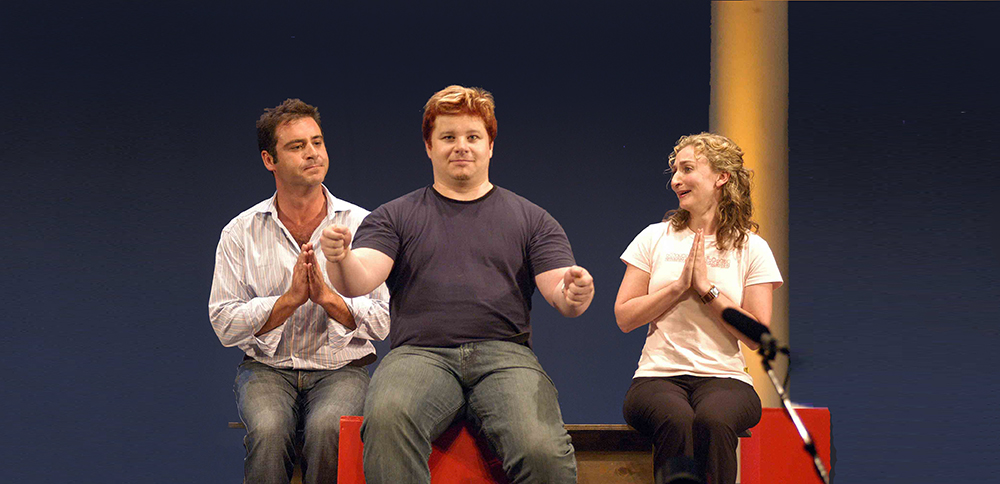Maestro™
Maestro (as it is now called) could be simply described as an elimination format. Players are called by the directors who set up the scenes and add input during the scene. The audience is asked to score the scenes and as the show goes on lower scoring players are eliminated.
As with all Keith’s formats what you see from the audience perspective is only a part of the show. It is the structure of the format and how it is designed to support the improviser in taking risks while creating spontaneous theatre that is real fun.
The best way of explaining Maestro would be to read what Keith has said about it.
Keith Johnstone’s newsletter Gorilla and Maestro (Nov. 98) pg.10
Maestro is another feed-back game, but the feed-back from the audience is more precise, and whereas Gorilla Theatre is for experts, Maestro™ is best when it’s played by a mix of experts and beginners. It began at Utrecht where tickets had been sold for a performance at the end of a four-day Summer school. All twenty-six students wanted to play Theatresports™, even though this is one of the more difficult impro-forms and most of them were novices (‘fools rush in…’etc.). I decided to accept everyone, and then ‘narrow the field’ in some way that was visibly unfair (so that the ejectes wouldn’t have to think badly of themselves).
Keith Johnstone’s newsletter Gorilla and Maestro (Nov. 98) pg.13-14
Maestro develops the skills of beginners speedily because it’s more effective to correct them mid-performance that to give notes afterwards. For example , a ‘silly Waiter’ who ruins a delicate love scene, can be sent back, perhaps again and again, until he/she present something believable.
It’s thrilling to see more and more of fewer but ‘hotter’ performers. Spectators will groan if a popular player is eliminated early, but that makes the game more poignant (sometimes the favourite at a steeple-chase falls at the first obstacle). We lessen the chance of this be delaying the eliminations until after Round Two.
Maestro is not a game for a cast of superb improvisers, because it’s depressing when every player who is eliminated is someone you wanted more of.
The director’s responsibility for the quality of the work becomes clear as soon as they shout instructions, and perhaps even restart scenes. You might expect this to ‘rattle’ the improvisers, but these intrusions absolve them from blame. If directors are skilled, Maestro is the least stressful for of public improvisation that we know.
Keith Johnstone’s newsletter Gorilla and Maestro (Nov. 98) pg.17
I would have invented this form decades ago had I realised that the spectators could agree on a score. Hysterically funny scenes, scenes with genuine emotion (pathos), and scenes that tell stories get FOURS and FIVES; whereas players who are just being silly get ONES and TWOS in spite of the laughter. This confirms my belief that laughter is misleading.
One of the pleasures of Maestro and Gorilla (at Loose Moose) is that the players do all that they can to improve other peoples scenes, i.e., having fun is more important to them than winning. Self-obsessed and mean-natured improvisers should stick to conventional impro unless they can learn to be supportive.
The problem with Maestro is that it needs brilliant directors. Train some, and Maestro will be the most pleasant and least stressful of all impro forms for the players.




